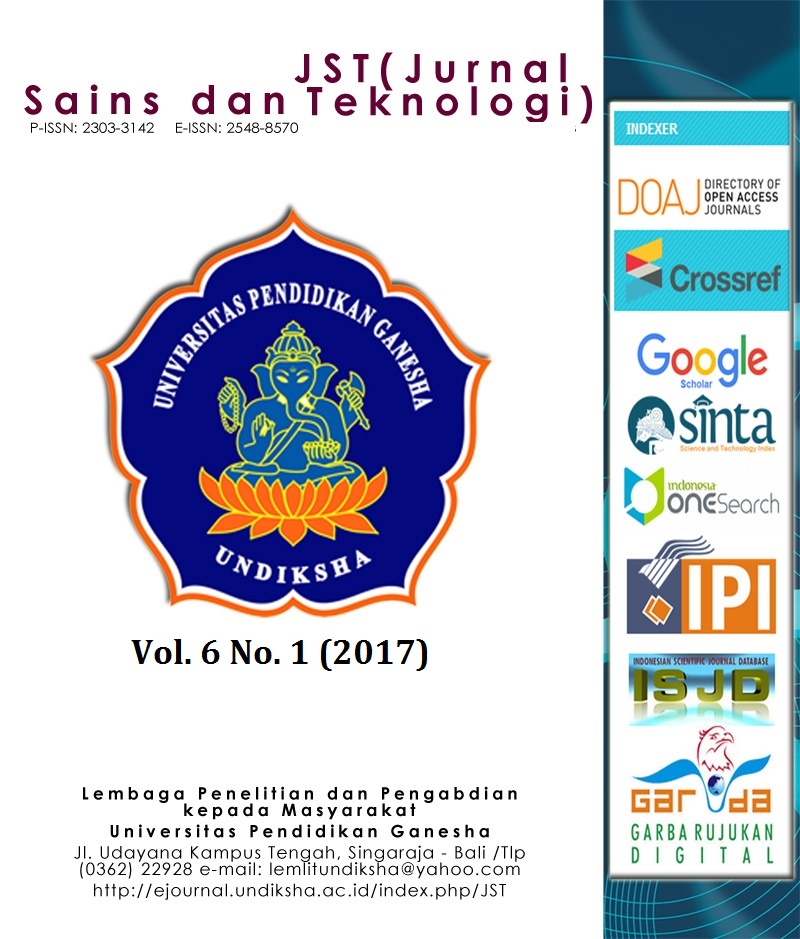ADSORPSI FENOL DENGAN HIDROTALSIT Mg/Al 4:1 TERMODIFIKASI SODIUM DODECYLSULFATE (SDS) IN SITU DAN EX SITU
DOI:
https://doi.org/10.23887/jstundiksha.v6i1.9438Kata Kunci:
hidrotalsit, sodium dodecylsulfate (SDS), adsorpsi, fenolAbstrak
Hidrotalsit (HT) telah disintesis dengan menggunakan Al(NO3)3·9H2O dan Mg(NO3)2·6H2O pada pH 10±0,5 dengan ratio molar Mg/Al adalah 4:1. Material tersebut dimodifikasi dengan Sodium Dodecylsulfate (SDS) dengan teknik sintesis ex situ dan in situ yang dinyatakan dengan HTDS ex situ dan HTDS in situ. Hasil karakterisasi FTIR menunjukkan munculnya puncak spektra infrared yang tajam pada 2920, 2851 dan 1065 cm-1 yang menunjukkan adanya gugus metil, metilen dan –OSO3- pada HTDS. Karakterisasi XRD pada HT, HTDS ex situ dan HTDS in situ menunjukkan pola difraktogram yang khas untuk material hidrotalsit. Adsorpsi fenol berlangsung optimum pada pH 3, 5 dan 3 untuk HT, HTDS ex situ dan HTDS in situ. Ketiga adsorben juga mengikuti model kinetika adsorpsi pseudo orde dua dan model isoterm Langmuir. Kapasitas maksimum HT, HTDS ex situ dan HTDS in situ masing-masing adalah 27,55; 17,64 dan 29,94 mg/g.
Referensi
Henous, M., Derrice, Z., Privas, E., Navard, P., Verney, V., & Leroux, F. (2013). Lignosulfonate iterleaved layered double hydrotalsite: A novel geen organoclay for bio-relatd polymer. Applied Clay Science, 71, 42–48.
Hernandez, M., Fernandez, L., Borras, C., Mostany, J., & Carrero, H. (2007). Characterization of surfactant/hydrotalcite-like clay/glassy carbon modifed electrodes: Oxidation of phenol. Analytica Chmica Acta, 597, 245–256.
Kurniawati, P., Wiyantoko, B., Kurniawan, A., & Purbaningtias, T. E. (2014). Kinetic Study of Cr(VI) Adsorption on Hydrotalcite Mg/Al with Molar Ratio 2:1. Eksakta, 13(1–2), 11–21.
Mokhtar, M., Saleh, T. S., & Basahel, S. N. (2012). Mg-Al Hydrotalcites As Efficient Catalysts for Aza-Michael Addition Reaction: A Green Protocol. Journal of Molecular Catalysis A: Chemical, 353–354.
Setshedi, K., Ren, J., Aoyi, O., & Onyango, M. S. (2012). Removal of Pb(II) from aqueous solution using hydrotalcite-like nanostructured material. International Journal of the Physical Sciences, 7(1), 63–72. https://doi.org/10.5897/IJPS11.1331
Sharma, S. K., Kushwaha, P. K., Srivastava, V. K., Bhatt, S. D., & Jasra, R. V. (2007). Effect of Hydrotermal Conditions on Structural and Textural Properties of Synthetic Hydrotalcites of Varying Mg/Al Molar Ratio. Industrial & Engineering Chemistry Research, 46, 4856–4865.
Sunil, K., & Jayant, K. (2013). Adsorption for Phenol Removal-A Review. International Journal of Scientific Engineering and Research, 1(2), 88–96.
Tao, Q., Yuan, J., Frost, R. L., He, H., Yuan, P., & Zhu, J. (2009). Effect of surfactant concentration on the stacking modes of organo-silylated layered doule hydroxides. Applied Clay Science, 45.
Wang, Q., Tay, H. H., Guo, Z., Chen, L., Liu, Y., Chang, J., … Borgna, A. (2012). Morphology and composition controllable synthesis of Mg-Al-CO3 hydrotalcites by tuning the synthesis pH and the CO2 capture capacity. Applied Clay Science, 55, 18–26.
Wiyantoko, B., Kurniawati, P., Purbaningtias, T. E., & Fatimah, I. (2015). Synthesis and Characterization of Hydrotalcite at Different Mg/AL Molar Ratios. Procedia Chemistry, 17, 21–26.
Yang, L., Shahrivari, Z., Liu, P. K. T., Sahimi, M., & Tsotsis, T. T. (2005). Removal of Trace Levels of Arsenic and Selenium from Aqueous Solutions by Calcinated and Uncalcinated Layered Double Hydroxides. Industrial & Engineering Chemistry Research, 44, 6804–6815.
Zhao, H., & Nagy, K. L. (2004). Dodecyl sulfate-hydrotalcite nanocomposites for traping chlorinated organic pollutants in water. Journal of Colloid and Interface Science, 274, 613–624.
Zhao, R., Yin, C., Zhao, H., & Liu, C. (2003). Synthesis, Characterization, and Application of Hydotalcites in Hydrodesulfurization of FCC Gasoline, Fuel Processing Technology. Fuel Processing Technology, 81, 201–209.
Zhu, J., Yuan, P., He, H., Frost, R. L., Tao, Q., Shen, W., & Bostrom, T. (2008). In situ synthesis of surfactant/silane-modified hydrotalcites. Journa of Colloid and Interface Science, 319, 498–504.
Unduhan
Diterbitkan
Cara Mengutip
Terbitan
Bagian
Lisensi
Authors who publish with the Jurnal Sains dan Teknologi (JST) agree to the following terms:
- Authors retain copyright and grant the journal the right of first publication with the work simultaneously licensed under a Creative Commons Attribution License (CC BY-SA 4.0) that allows others to share the work with an acknowledgment of the work's authorship and initial publication in this journal.
- Authors are able to enter into separate, additional contractual arrangements for the non-exclusive distribution of the journal's published version of the work (e.g., post it to an institutional repository or publish it in a book), with an acknowledgment of its initial publication in this journal.
- Authors are permitted and encouraged to post their work online (e.g., in institutional repositories or on their website) prior to and during the submission process, as it can lead to productive exchanges, as well as earlier and greater citation of published work. (See The Effect of Open Access)
















